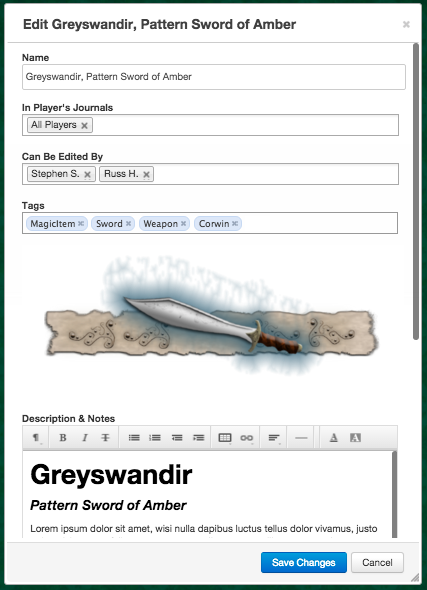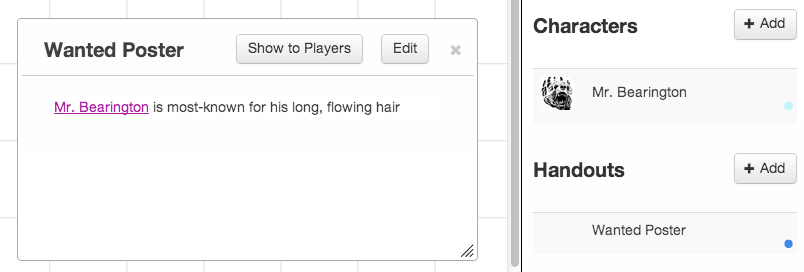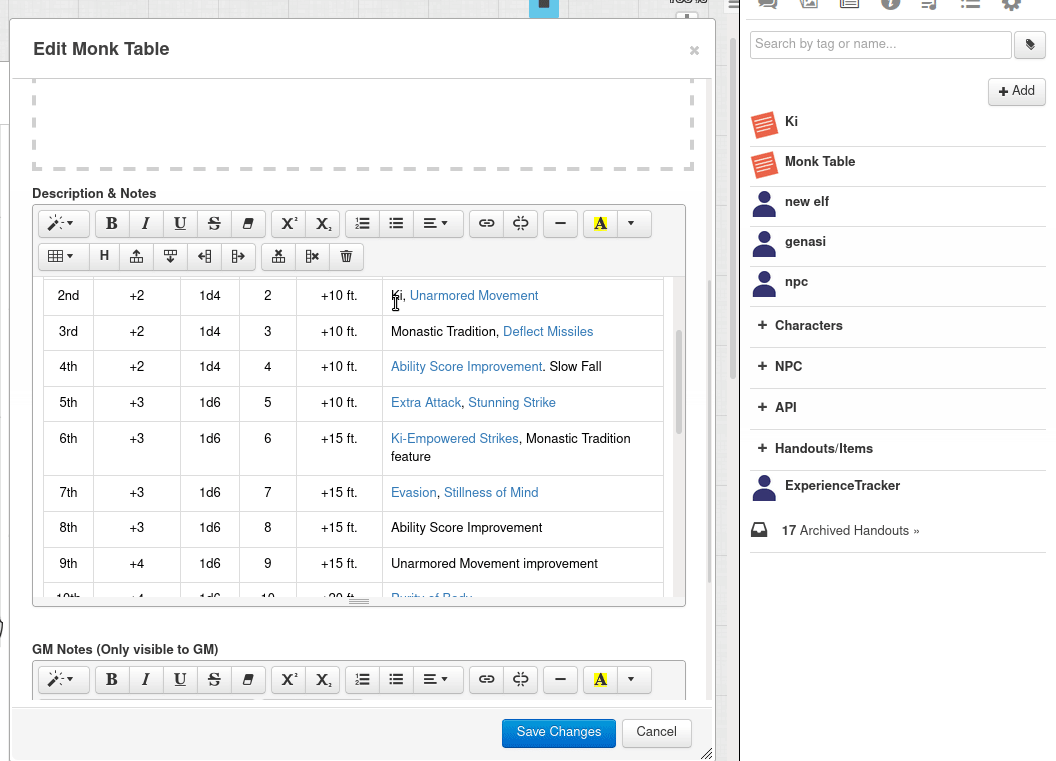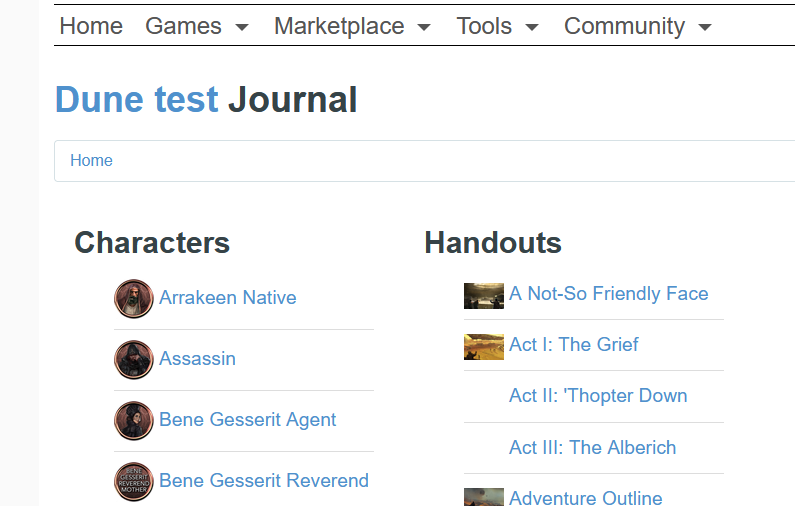Handout
From Roll20 Wiki
Page Updated: 2023-02-20 |
Sidebar
q Text Chat
P Art Library
N Journal
i Compendium
u Jukebox
l Collections
y My Settings
Handouts are found and managed on the N Journal, and only a GM can create them. They work differently than Characters.
Handouts are very similar to Characters, and have some of the same fields.
Contents |
Handout Dialog
When you click on a Handout in the Journal Listing, it will open the Handout Dialog. This is where you view the contents of the Handout, including the Image (if one is associated), the Description & Notes text (if any has been entered) and the GM Notes (if the viewer is a GM).
If you include an image that's larger than the Handout Dialog, a magnifying glass will appear over the image when you view the Handout. Clicking on the image in the Handout Dialog will display either the original dimensions or a full-screen version of that image.
The Name of the Handout will be shown across the top of the Handout Dialog with several buttons:
Pop-Out Button
This button is to the left of the Name and looks like two overlapping rectangles. Clicking it will open the character/handout in a separate browser window from your primary Roll20 window, which can then be moved independently, viewed side-by-side with your Roll20 Game page, moved to a different monitor, or switched between with your operating systems native commands.
| See Character Sheet in a separate window for issues & limitations of character sheets when they are popped out. Some sheet features don't work when they are popped out. |
Show To Players Button (GM Only)
This button is to the right of the Name and allows the GM to cause the Handout Dialog to be displayed on the screens of any players that can View the Handout. If no players can View the Handout, a dialog will prompt the GM and ask if it should be shared with all players. Clicking Show to Everyone will insert All Players into the In Players's Journals field of the Handout (see below).
Edit Button
The GM always has this button, as do any players that can Edit the Handout because of inclusion in Can Be Edited By (see below). Clicking this button will move the Handout Dialog into the Editing view.
Editing
The Editing view of the Handout Dialog allows GMs and players who can Edit to make changes to the Handout.
Handout Editing & Formatting:
You can copy-paste content from outside Roll20 into the Editor, and the styling will stay, enabling you style your handouts, beyond the editor's normal tools.
Name
You can change the default text of Mysterious Note to whatever you like. This will be the title of the Handout in the Journal tab, and will show across the top of the Handout Dialog when it is opened.
In Player's Journals (GM Only)
Just like for Characters, the GM is the only person that can see a Handout by default. You can allow viewing by select players by putting their name in this field, or select All Players to allow access to all. Players with a Handout in their journal will be able to view it whenever they like. It will be shown in whatever folder the GM has put it in, complete with the name of the folder. You may want to move a handout before allowing your players to view it (For example, if it is in the Cursed Items folder).
You can also drag and drop a Handout from the Journal tab in the right sidebar onto a player. That player will be given permission to view the Handout, and it will also appear on their screen immediately.
Can Be Edited By (GM Only)
Similar to the In Player's Folder, by default only the GM can edit a Handout. Placing a player's name in this field allows that player to both View and Edit that Handout. This is particularly useful for allowing players journals or secret notes for correspondence with the GM. The same notes about folders apply as with the above.
Tags (GM Only)
The Tags field allows you to assign words to associate with this Handout which are useful for finding it later via the Search field or the Tag List Dropdown.
Image
You can upload an Image to represent this Handout in the Journal listing.
Either drag & drop an image from your computer, or drag a& drop an image from your P Art Library.
Description & Notes
This field lets you associate a freeform block of text with the Handout. This text is visible to players that can View the Handout and editable by players that can Edit the Handout.
GM Notes (GM Only)
This field is just like Description & Notes save that only the GM can edit and view it, regardless of other settings.
Duplicate Handout (GM Only)
The Duplicate-button creates a copy of the handout, named "Copy of (name of handout)", which will appear at the bottom of the journal. Multiple copies of the same handout will all be named "Copy of..." when created, though these can all be renamed as needed.
Archive Handout (GM Only)
The Archive-button will move the Handout to a special area where it will no longer show up in the Journal Listing or in results from the Search field or Tag List Dropdown. Archived handouts can be accessed in the Archived Handouts Dialog at the bottom of the Journal Listing, and can be restored there.
Delete Handout (GM Only)
The Delete Handout- button will prompt for confirmation and then permanently remove the Handout from the Game.
Journal Options
main: N Journal
Link Between Journal Entries
You can easily create links between your Journal Entries(Handouts & Characters).
Put single brackets around the name of a character or handout (for example: “[Mr. Bearington] is most-known for his long, flowing hair”), and when you save the entry, it will automatically create a clickable link to the other journal entry. Links to other handouts are purple, while links to compendium entries or other hyperlinks are blue.
It works both inside and outside the app, and it’s smart enough to obey player permissions as well (so a player can’t open a handout they don’t have access to, even if they see a link to that handout).
You can use the links in character bio, GM notes (both for characters and tokens), and for handouts in the Description & Notes-field. Use links to tie entries together, or even create a “table of contents” page for your game to quickly access your most-used journal items.
Linking to a Compendium Page
If your game uses a i Compendium, links to that compendium in handouts and character sheets will automatically open a handout from the in-app compendium. Use the full URL in the link in the text editor, including the https:// part of the URL, but do not include bookmarks and arguments (anything that's after a ? or # in a copied URL).
If you access the External Compendium, you can search and navigate to the pages you want and simply copy the URLs from the address bar.
Example:
To link to the D&D 5E Rogue's compendium page, save the following as the link in the handout: https://roll20.net/compendium/dnd5e/Classes:Rogue
Journal Command Buttons
Within the Bio & Info and GM Notes text fields of a Character, or the Description & Notes and GM Notes text fields of a Handout, you can create Journal Command Buttons; special hyperlinks that can output macros to the Text Chat when clicked.
Here's how to create a Journal Command Button within one of the aforementioned fields:
- Insert a link using the link button on the redactor toolbar.
- At the very start of the "URL" field of the Link Window, type a backtick character:
` - Add in your macro code after the
`character. - Give your Journal Command Button a label using the "Text" field.
- Press the "Insert" button and Save Changes; you have created a Journal Command Button!
Another way to create Journal Command Buttons is to copy and paste an API Command Button or Ability Command Button from the Text Chat into one of the aforementioned text fields.
Note: Journal Command Buttons will not work if you have the Use Window Popouts for Characters option enabled.
External Journal Access
Main Page: External Journal
Located on the Game Details page, under the Content dropdown menu, along with access to your Chat Archive and Game Forums.
This is great for checking up on things in-between gaming sessions without the hassle of loading up the whole tabletop. You can also keep the External Journal open in a separate tab or browser window, or even on another screen.
The External Journal updates in real-time. So if a change is made to a character’s bio, you don’t need to reload, you’ll see the change right away. This really enables you to use the External Journal as a play aid during your Roll20 games.
Trick:
- If you have large handouts & need to search them for a certain word, you can open them in the External Journal and use
ctrl+Fto find it, where as you can't usectrl+Finside Roll20.- Search API(Forum) -- provides full text searching across handouts and characters (including attributes). Search respects permissions on handouts and characters.
Related Pages













